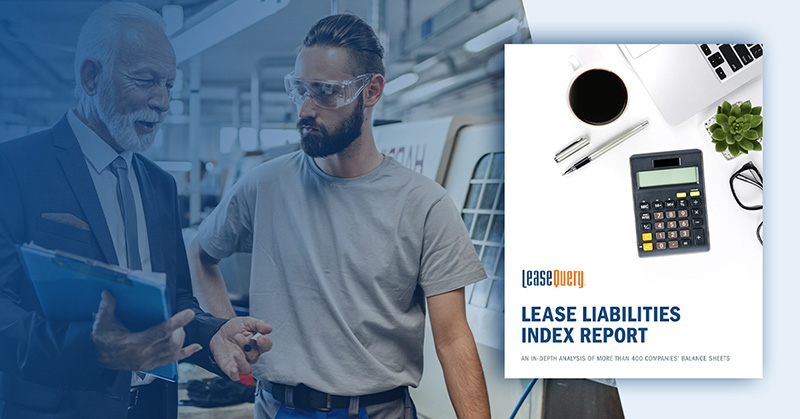Manufacturers will add millions of dollars of lease liabilities to the balance sheet this year to comply with new rules.
By Jennifer Booth
The manufacturing industry has faced significant financial challenges recently – from volatility in commodity prices and markets, to tariffs. While those issues have rightfully occupied their time, a new lease accounting regulation is about to upend their balance sheets, and manufacturers need to get ready. The biggest change to happen to lease accounting in 40 years, Accounting Standards Codification Topic 842 (ASC 842), issued by the Financial Accounting Standards Board (FASB), requires that companies recognize massive amounts of dollars in lease payments on their balance sheets by January 2021.

LeaseQuery’s Lease Liabilities Index analyzed over 400 companies’ balance sheets pre- and post-transition to the new accounting regulation.
Based on an analysis of more than 400 companies’ balance sheets pre- and post-transition to the new rule, the Lease Liabilities Index revealed a staggering 495 percent liability increase in manufacturers’ balance sheets as a result of this mandatory accounting change. Behind the big numbers is also a big effort. Transition requires time, resources, staffing and technology to aid in the process. Manufacturing companies are advised to closely assess lease agreements not only throughout the business but also throughout the firm’s supply chain. This is no simple task. With this deadline only a matter of months away, manufacturers must act now.
Here are some key takeaways for manufacturers to put to work when implementing the new accounting standard this year.
Understand the New Rules
To begin the journey to compliance, it’s essential for manufacturing companies to understand the new guidance and its impact on their business. Under the new accounting guidance, all leases, which includes finance and now operating leases, are to be recorded on companies’ balance sheets. A survey of over 200 accountants showed that 67 percent of companies in the later stages of their lease accounting transition experienced difficulty with the implementation, while just 37 percent in earlier stages anticipated difficulty. The regulation was so challenging for public companies that the FASB extended the implementation deadline for private companies and has scheduled a Roundtable meeting to discuss the areas that were problematic for public companies. As the transition process is complex and time-consuming, private manufacturers should heed the advice of those who have already transitioned and begin transitioning sooner rather than later.
Dig Deep to Locate Embedded Leases
Once familiar with ASC 842, manufacturers must identify and analyze all lease agreements in detail. To do this, manufacturers should contact all company departments in order to understand the various lease arrangements since leases and contracts are not always stored in the same place or handled by the accounting department. For instance, many service agreements could be engaged by departments such as procurement, IT and operations, requiring complete collaboration and communication across the entire organization and supply chain.
Part of what makes the transition process so complex for manufacturers is that leases come in a variety of shapes and sizes. For example, manufacturers are likely to have leases of equipment, machinery, vehicles, operation plants, distribution centers and IT services. In addition, many service contracts may contain embedded leases, lease agreements that exist within contracts. It is important to determine if a contract contains an identified asset and if the right to “control” that asset is determined by the lessee. Furthermore, for a lease embedded in a service contract, it is necessary to separate the contract into lease and non-lease components. The nature of embedded leases makes it all the more necessary for internal collaboration to ensure accurate reporting on the balance sheet to comply with the new standard.
Next Steps to Compliance
With a solid understanding of the new lease accounting regulation, manufacturers can embark on the road to implementation, which can take up to a year. Given the complexity of the transition process and the time needed for compliance, it behooves manufacturers to solidify their tools and allocate internal team resources in order to tackle this matter swiftly. According to a survey, 56 percent of companies had only one or two staff members or external consultants on their transition team, making the implementation process all the more time-intensive.
Along with a team of trained professionals, the use of software tools is paramount. Software solutions that were created specifically for adoption of the regulation make implementation easier as they address accounting and disclosure requirements. This, in turn, makes the calculation of lease liability and corresponding lease assets based on system-generated amortization schedules much easier and generation of disclosure reports at the click of a button, while also enabling greater accuracy.
Though the implementation process might seem daunting to some manufacturing companies, there is a benefit to the work—greater efficiency. The centralization of information related to lease accounting can help businesses’ treasury departments with more complete information to enable more accurate lease vs. buy decisions. Further, the aggregation of this data can allow teams to monitor notice periods and renewal/termination periods to help companies manage their lease costs.
January 2021 will arrive in the blink of an eye. It’s imperative that manufacturers act quickly to implement the new lease accounting regulation. Take the advice of public companies and get started now.

Jennifer Booth
Jennifer Booth, VP of Accounting, LeaseQuery, has nearly 20 years of experience in her field. She spent the majority of her career at EY before joining LeaseQuery where she assists clients as they adopt new regulations that change the way companies account for their leases. She also serves as a key resource for training LeaseQuery’s internal accountants on the intricacies of lease accounting.
Scott Ellyson, CEO of East West Manufacturing, brings decades of global manufacturing and supply chain leadership to the conversation. In this episode, he shares practical insights on scaling operations, navigating complexity, and building resilient manufacturing networks in an increasingly connected world.